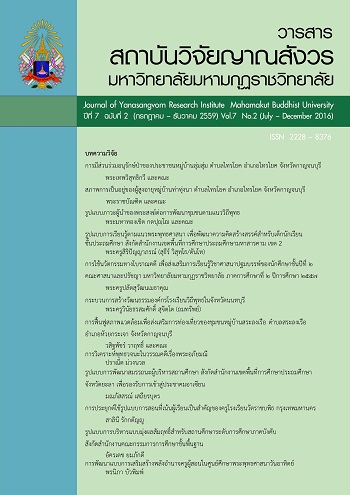The analytical study of Buddha’s utterances in Phra Abhaimani
Main Article Content
Abstract
The analytical study of Buddha’s utterances in Phra Abhaimani aims at 1) analyzing Buddha’s utterances referring in Phra Abhaimani and 2) examining practical methods and maintenances of Buddha’s utterances in the literature. Qualitative and quantitative methodologies have been mixed by gathering questionnaires formed by Yamane’s method from 18 lecturers and 265 students from department of Thai language, faculty of education, Bansomdejchaopraya Rajabhat University in the academic year 2014. The results of research were found as follows: 1) Sunthon Phu’s experiences and world views have been used to characterize several literary characters that lead to the theme. Phra Abhaimani character, which base on metaphysic, represents impermanence, suffering and nirvana path. Phi Sue Samut character represents non-self and paticcasamuppada (dependent origination). Utterances of King Thotsawong, Srisuwan, Bishop Pipo, Yogi, Sutsakhon, Nudist and Wali manifest impermanent mental state and epistemology. In additional, the main idea about keeping one’s word, loyalty and compassionate reflexing on Phra Abhaimani’s deeds and on some sayings that derived from Buddism brings about the literature value, especially through the ways how the characters coped with problems that universally remind readers to live with a precaution. 2) Among representative samples, there are high level of all maintenance, self-behavior and promotion of Buddha’s utterances mentioned in Phra Abhaimani.
Article Details
References
นิธี เอียวศรีวงศ์. (2538). ปากไก่และใบเรือ ว่าด้วยการศึกษาประวัติศาสตร์ วรรณกรรมต้นรัตนโกสินทร์. (พิมพ์ครั้งที่ 2). กรุงเทพฯ: อมรินทร์บุ๊คเซ็นเตอร์.
รังสรรค์ เมืองพรหม. (2557). การตีความเรื่องพระอภัยมณีของสุนทรภู่ ตามทัศนะของสุนทรียศาสตร์ตะวันตกทางด้านวรรณกรรมและดนตรี. วิทยานิพนธ์ศิลปศาสตรมหาบัณฑิต (ปรัชญาและศาสนา) บัณฑิตวิทยาลัย มหาวิทยาลัยเกษตรศาสตร์.
วิเชียร เกษประทุม. (ม.ป.ป.) เล่าเรื่องพระอภัยมณี. กรุงเทพมหานคร: เรืองแสงการพิมพ์.
สุนทรภู่. (2554). พระอภัยมณี เล่ม 1. (พิมพ์ครั้งที่ 2). กรุงเทพฯ: เพชรกะรัต.
สุนทรภู่. (2554). พระอภัยมณี เล่ม 2. (พิมพ์ครั้งที่ 2). กรุงเทพฯ: เพชรกะรัต.
สุนทรภู่. (2554). พระอภัยมณี เล่ม 3. (พิมพ์ครั้งที่ 2). กรุงเทพฯ: เพชรกะรัต.
สุนทรภู่. (2554). พระอภัยมณี เล่ม 4. (พิมพ์ครั้งที่ 2). กรุงเทพฯ: เพชรกะรัต.
เสฐียรพงษ์ วรรณปก. (2537). พุทธวจนะในธรรมบท. (พิมพ์ครั้งที่ 8 ) กรุงเทพ ฯ: อมรินทร์พริ้นติ้ง แอนด์พลับสิชซิ่ง.
โสภณ พฤกษวานิช. (2539). พุทธปรัชญาเถรวาทในพระอภัยมณี. วิทยานิพนธ์ศิลปศาสตรมหาบัณฑิต สาขาวิชาภาษาไทย (สายวรรณคดี) มหาวิทยาลัยสงขลานครินทร์.
โอสถ โกสิน. (2544). บทเรียนเขียนกลอน. “การศึกษาคำกลอนสุนทรภู่ เรื่องพระอภัยมณี” กรุงเทพฯ: โรงพิมพ์หอรัตนชัยการพิมพ์.

